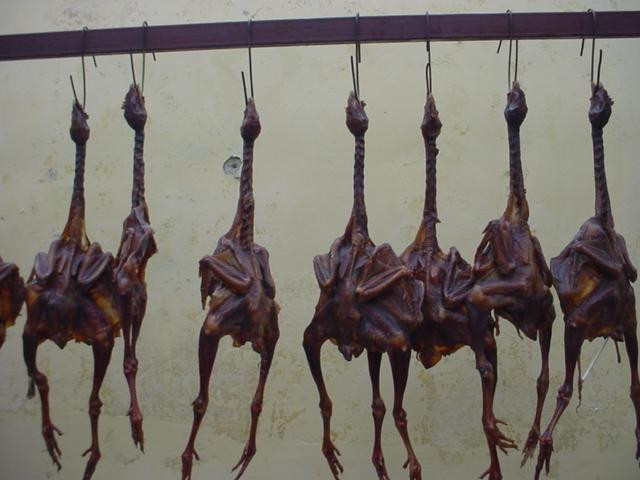The story of the cuisine
The dish has a rather romantic name: "wind chicken" - but the way to make it is strongly condemned.
For thousands of years, human cuisine has steadily advanced, with a wide variety of dishes and flavors. In it, there are dishes that even represent an entire culture - like Italy with pasta, pizza; Japan has sushi; or Vietnam we are pho.
However, besides, there are also many dishes that the way of making itself is a controversy. For example, the pride of French cuisine - foie gras or fattening foie gras - one must feed geese with a cruel process to obtain that liver. Or the soup of shark microbes in China is condemned by the whole world due to fishermen 's excessive and emotionless hunting.

Foie gras fattening foie gras (left) and foie gras often (right).
Today, we will come with a similar dish. It is "wind chicken" - or Feng gan ji - of Tibetans and Chinese. This dish has a rather . romantic name, but it requires a chef to have a cold heart.
Hong Kong wind - the "iron" dish of Tibetans
The cold highlands of Tibet, where the cold wind easily reaches below 0 degrees Celsius, people have a kind of food that can be considered "specialties" - a dish of windy meat.
Basically, the exposed meat of Tibetans is almost similar to the bacon in the West: the meat is dried in a cool, shady place, so that the wind blows naturally. This is a way to preserve meat, for the next few months or a year.
The meat used for drying can be goat meat, beef. But with chicken alone, the processing is raised to another level, different to . scary.

The wind chicken of Tibet.
To make the wind chicken, the ingredients are simple: a raw chicken, a sharp knife, herb spices, a skilled chef but the heart is cruel.
Unlike normal chicken, the chicken will not be feathered if it is air conditioned. Instead, it will be slaughtered while living, dragging the entire intestine, liver, phlegm, lungs . in a heartbeat. Next, the chef immediately rubbed salt, herbs into the chicken intestines, rubbed so that the chicken belly saturated with spices.

The whole process must be done extremely quickly to keep the chicken raw.
The process of marinating ends, the chicken will be hairy and hang up in front of the wind. At this time, he was still alive, and then the cold wind and the pain in the end would gnaw them until the poor creatures said goodbye to this filthy life. Their bodies will remain there until they dry and . on the disk.
The whole process must be done extremely quickly to keep the chicken raw. And you know, chickens may not be able to think, but they know how to cry when they are hurt. Therefore, the moan of the chickens in the afternoon may not be too strange if you come to Tibet at the end of the year.

The crying moans of chickens in the afternoon may not be too strange if you come to Tibet at the end of the year.
According to the concept, leaving chickens alive in the processing process to ensure the freshness of the chicken, help balance the yin and yang, and can even be considered as "great food ".
Processing is condemned
In fact, hens are not only in Tibet. Historically, this wind chicken has originated from the Three Kingdoms era. This is a famous traditional dish of Han people. The advantage of this dish is that it is easy to preserve, it does not lose the freshness, soft aroma, no grease, the young and old can be eaten.
Legend has it that, during the Three Kingdoms period, Ton Quyen wanted to match Liu Bei to Cao, his younger sister Ton Thuong Huong married Liu Bei. Luu and his wife lived in the village of Thap Ly, a suburb of Kinh Chau.
Because Liu Bei loves to eat chicken, Ton Thuong Huong wants to please her husband, and then devises many methods of processing chicken, including this wind chicken. Over time, it has become more popular, popular.

Luu Be's hobby has indirectly formed this traditional chicken dish.(Illustration).
However, this way of processing is condemned for being too cruel. The groan of pain of the chicken before death caused many witnesses to cover their faces. Some also shared: "I feel like screaming chickens, questioning why humans do this cruel thing to them."
So, nowadays, only Tibetans continue to "make chickens" in this way. In big cities, the hens are still popular, but the chicken will be cut off before processing, helping them to get on the road quickly and with little pain.
However, many people believe that the current processing makes chicken dish inherently delicious. And you? Do you want to enjoy this dish the traditional way, or the less cruel variant of modern people?
- Learn about exotic mushrooms in Japanese cuisine (2)
- Discover the magic number 5 in Japanese culinary culture
- 7 impressive things you don't know about Uzbekistan
- Detect the origin of the story
- Terrifying eating animals of the kings made the servants frightened
- Grilled lilies - sumptuous and cruel cuisine
- The village has 300 people living 100 years by eating this spice leaf!
- Western dishes for the Christmas season
- The living food is not for the faint of heart
- The 3 most basic principles when enjoying French bread - a delicate dish
- 'Interactive food' - A great combination of cuisine and technology
- The truth behind the gold-plated dishes of the super rich world
 'Fine laughs' - Scary and painful torture in ancient times
'Fine laughs' - Scary and painful torture in ancient times The sequence of numbers 142857 of the Egyptian pyramids is known as the strangest number in the world - Why?
The sequence of numbers 142857 of the Egyptian pyramids is known as the strangest number in the world - Why? History of the iron
History of the iron What is alum?
What is alum?